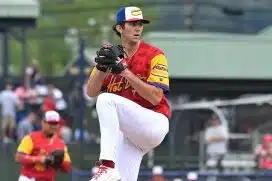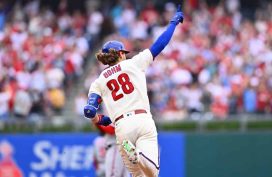By Matt Albertson, Historical Columnist
The 1983 Phillies are the most forgotten contender in franchise history. Dubbed the "Wheeze Kids" by legendary Philadelphia sportswriter Stan Hochman as the aged antithesis of the franchise-famed 1950 NL champion "Whiz Kids", the 1983 Phillies won the National League pennant behind aging veterans and four future Hall of Famers. The second oldest member of the club was future Hall of Famer Tony Perez.
The Phillies signed Perez as a free agent in January 1983, inspiring Philadelphia Inquirer columnist Peter Pascarelli to jest "break open the Geritol and welcome the newest addition to the cast of baseball's version of On Golden Pond." Perez joined former teammates Pete Rose and Joe Morgan, members of the famed Big Red Machine – the nickname bestowed to the great Cincinnati Reds clubs of the 1970s – on an increasingly aged Phillies team, who had seven players 38 years old or older in the clubhouse. He was brought in to be a pinch-hitter but played 69 games, with 63 starts, in the field at first base, registering an above average .998 fielding percentage and committed only one error. In 91 total games, he slashed .241/.316/.372 with 11 doubles, 6 home runs, and 43 RBI. He played in four of the five World Series games in 1983, where he had two hits in 10 at-bats.
Perez broke into the major leagues with the Cincinnati Reds in July 1964 and established himself as one of the most reliable hitting first basemen in baseball, appearing in four straight All-Star games between 1967-1970 and in three straight between 1974-1976. His most prolific season was 1970, when he slashed .317/.401/.589, with 28 doubles, 40 home runs and 129 RBI. Perez ended up 3rd in the NL MVP voting. Despite hitting well in the 1970 NLCS, Perez only registered one hit in 21 plate appearances against Baltimore in the World Series. Perez played in 47 post season games and slashed .238/.291/.378 with 6 doubles, 6 home runs, and 25 RBI.
Perez returned to the Reds following the 1983 season, where he finished his 23-year career in 1986. A year later, he was brought on as a coach with the Reds, winning a third World Series with the Reds and first as a coach in 1990 with the "Nasty Boys". He was elected to the National Baseball Hall of Fame in 2000.
Career Accomplishments
- 2000 Hall of Fame inductee (77.2% of BBWAA vote)
- Played 23 years with 4 teams
- Seven-time All-Star (1967-1970, 1974-1976)
- 1967 All-Star game MVP
- 1980 Lou Gehrig Memorial Award
- Three-time World Series champion (two as a player 1975 and 1976, once as coach 1990)
*Awards were not factored into the formula
Career Defining Moment
Tony Perez started the 1975 World Series 0-for-15 but exploded in Game 5, going 2-3 in four plate appearances, hitting two home runs off of Red Sox starter Reggie Cleveland. His four RBI helped lead the Reds to a 6-2 victory.
The win put the Reds up 3-2 in the series, setting up one of the greatest games in World Series history, where Red Sox catcher Carlton Fisk hit his infamous 12th inning home run off Pat Darcy at Fenway Park. The Reds eventually won the series four games to three.
Reasoning for ranking
Perez scored 37 points in our formula. He totaled 53.9 WAR, averaging 2.34 WAR over his 23 seasons. He had 12 seasons of 2+ WAR and 4four seasons at 5+ WAR, totaling 27 points. His 2,732 hits are 59th all-time, his 505 doubles are 59th all-time, his 379 home runs are 71st all-time, and his 1,652 RBI are 30th all-time. These all-time ranks netted Perez 10 additional points.
Perez scored a 2 out of 10 on our subjective importance scale because he was merely a backup to Pete Rose on a veteran-dominated team which also included Mike Schmidt, Joe Morgan and Steve Carlton.
Explanation of scientific formula
The player rankings formula combines both traditional and advanced statistics/metrics and assigns a point total to each category.







